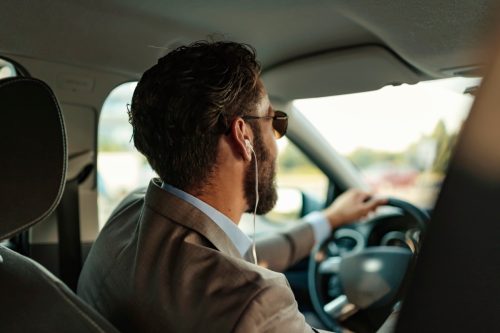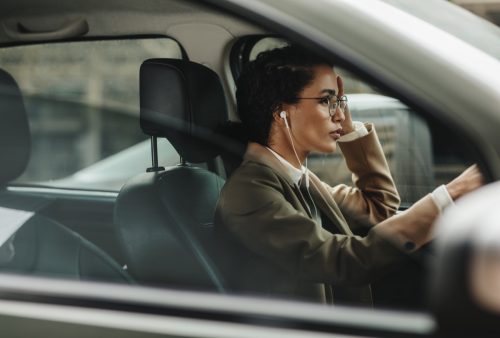Never Wear This One Accessory While Driving, Experts Warn

Whether it’s being rear-ended at a red light or getting T-boned at an intersection, most of us have been involved in a car accident at some point—or at least come very close. According to the National Highway Traffic Safety Administration (NHTSA), there are usually more than six million motor-vehicle crashes reported to police every year in the U.S. And while even the safest of drivers can easily find themselves in a collision, there are a number of ways you could be making the road a more dangerous place for yourself, and for those around you. Experts warn that what you’re wearing while in the driver’s seat might play a part in your likelihood of running into trouble. Read on to find out what one accessory you should never have on while you’re driving.
RELATED: If You’re Over 60, Never Wear This While Driving, Doctors Warn.
You should never wear headphones while driving.

A long drive is the perfect time to listen to your favorite music or catch up on on the latest podcasts. But the way you’re listening while you drive is extremely important. “Wearing headphones while driving is completely unsafe,” warns Jae Pak, MD, a health expert who is board-certified in emergency medicine. According to Pak, drivers who do this are eliminating a key sense that is meant to keep them safe while on the road.
“Whilst visual cues—keeping your eyes on the road—are of primary importance, there are plenty of audio cues that we should take note of while we’re driving,” says Robert Muñoz, a driving expert and founder of SensibleMotive. “Whether it’s a distant police siren that signals a glance in the mirror or the rumble of an 18-wheeler in your blind spot, staying alert to every sense will keep you safe while driving.”
A study found that drivers who use headphones are less responsive.

In 2021, Ford released the results of a study they conducted in Europe to assess the effects of wearing headphones while driving. The American automotive company led a driving stimulation with 2,000 participants using virtual reality and 8D audio to create a realistic driving environment. The participants were divided up into two groups—one with no headphones and the other with—and then asked to identify sounds that were created by the audio technology.
According to the study, drivers who were listening to music with headphones in the car had a response time to sounds that was 4.2 times slower than those not wearing headphones. After the experiment, the Ford researchers noted that 58 percent of the participants said they would no longer wear headphones or earbuds while operating a vehicle.
“Sound plays a vital role in our ability to understand our environment—we very often hear important events happening around us before we see them,” Maria Chait, PhD, a professor of auditory cognitive neuroscience at University College London, said in a statement. “While headphones can be beneficial to us in many circumstances, on the road they can block out important sound cues, meaning we might not be able to perceive nearby vehicles or road users, potentially putting them—and us—in danger.”
RELATED: For more safety advice delivered straight to your inbox, sign up for our daily newsletter.
It’s illegal to wear headphones while driving in some states.

If science isn’t enough to convince you to take out your earbuds while driving, maybe the law is. According to VanderDerGinst Law, the regulations on drivers wearing headphones differs from state to state. In some states, it’s 100 percent legal, but in others, it’s actually against the law. You are not allowed to wear headphones while operating a vehicle in Alaska, California, Colorado, Florida, Georgia, Louisiana, Maryland, Massachusetts, Minnesota, New York, Ohio, Pennsylvania, Rhode Island, Virginia, and Washington, per the law firm. Some of these states have a few exceptions, such as wearing hearing aid devices or if you’re emergency personnel, like firefighters or police officers.
“From Maryland to Louisiana, a pair of headphones could put you on the wrong side of the law, and make you liable for greater damages if you do have an accident,” Muñoz warns. But there are many states where it is legal, albeit still dangerous. According to VanderDerGinst Law, some of the states that currently have no laws against drivers wearing headphones include Idaho, New Jersey, South Carolina, and Wyoming.
There are ways you can make wearing headphones while driving a little safer.

Not everyone is willing to change the way they drive, even if they know it’s dangerous. But when it comes to wearing headphones while driving, there are a few ways you might be able to make this unsafe habit a bit safer. “The first thing would be to only put one earbud in,” Muñoz recommends. “Ditch the left earbud so that you’re still attentive to traffic sounds coming from your blind spot.”
According to the driving safety expert, doing this may also put you on the right side of the law in some states. This is because many states that ban the use of headphones while driving—like Georgia and Florida—actually operate on a one-ear rule, per Drive Safe Online. With this rule, you can use an earbud or Bluetooth wireless headphone when behind the wheel as long as it’s only in one ear and the other ear is free to listen out for external sounds.
Another tip to making this practice safer is to just lower the volume. “If it’s music that’s blaring in your headphones, turn it down. Of course, for many people, this might defeat the purpose of wearing headphones in the first place, and if so then I suggest you ditch the headphones altogether—you can still sing along to the car stereo,” Muñoz says.
RELATED: Never Wear This One Thing While Driving, Experts Warn.